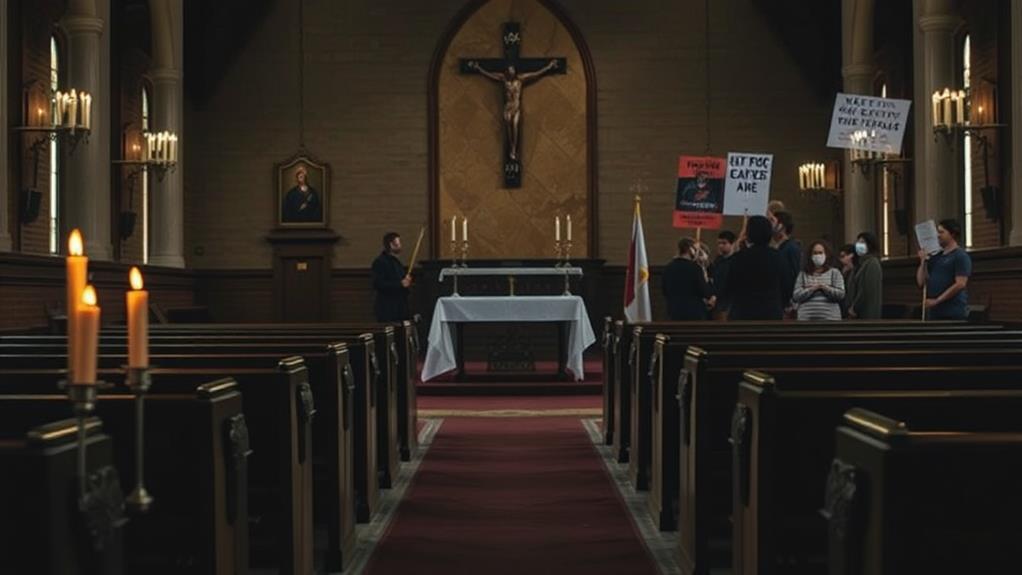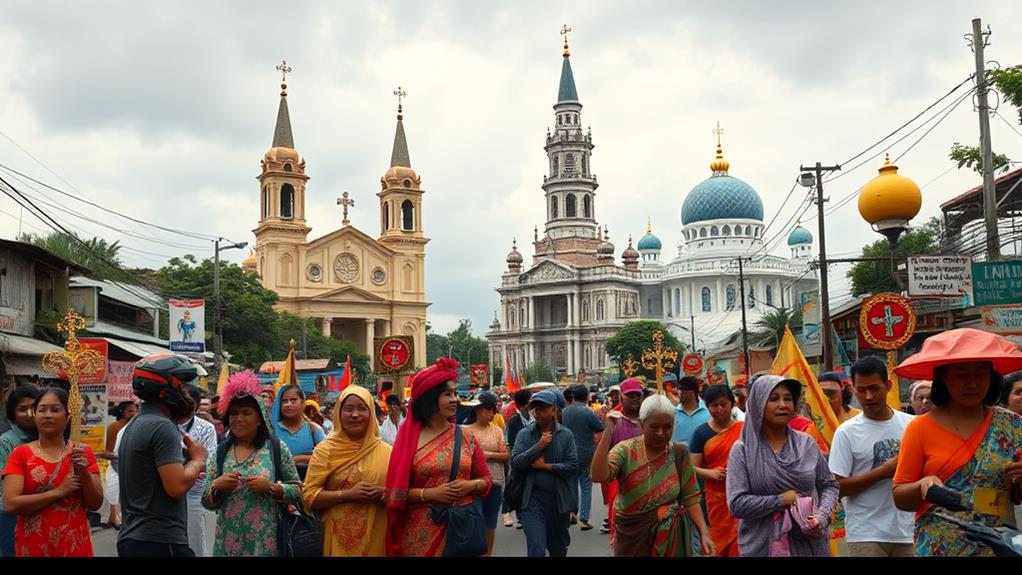Religious institutions in the Philippines face significant challenges. One major issue is the decline in youth participation, as many younger Filipinos prioritize social activities over religious events. For instance, a study found that only 30% of Filipino youth attend religious services regularly, compared to 60% of adults.
Financial constraints also hinder religious institutions. Limited funds restrict outreach and community support, making it difficult to provide essential services to their congregation.
Competition from other sects further complicates matters, as they compete for followers and resources.
Interfaith tensions, particularly between Christian and Muslim communities, add another layer of difficulty. Historical conflicts and cultural differences contribute to these tensions, making it challenging for religious institutions to build bridges between communities.
Government policies can restrict religious freedom, impacting community engagement efforts. For example, some laws may limit the ability of religious institutions to openly practice their beliefs or express their opinions on certain issues.
To remain relevant and effective, religious institutions in the Philippines must develop innovative strategies to address these challenges.
By understanding these issues, religious institutions can adapt and evolve to meet the changing needs of their communities.
Current Challenges in Religious Institutions

Declining Youth Participation
Religious institutions in the Philippines face a significant challenge: declining youth participation in Mass.
Many young people prefer socializing in malls, leading to a drop in Catholic attendance. This trend affects faith transmission, as younger generations become increasingly disconnected from traditional religious practices.
Financial Barriers
Financial constraints also hinder the effectiveness of religious institutions.
Many couples struggle to afford church weddings, which diminishes the church's influence on family formation and community cohesion. The rise of sect competition, particularly from groups like Iglesia ni Cristo, further complicates matters, as these sects attract disenchanted members, exacerbating the decline of Catholic institutions.
Persistence of Pagan Practices
The persistence of pagan practices, especially in rural areas, challenges the effective transmission of Christian values.
This creates a disconnect between religious teachings and community beliefs. For instance, some rural communities still practice ancient rituals and beliefs, making it difficult for religious institutions to instill Christian values.
Social Issues
Ongoing issues of drugs, violence, and family breakdown contribute to a disengaged populace, making community engagement within religious institutions increasingly difficult.
These social issues distract from the core mission of religious institutions, which is to provide spiritual guidance and support. As a result, religious institutions must adapt to address these challenges and remain relevant in the lives of Filipinos today.
Impact of Government Policies
The Philippine government's policies significantly influence the operations of religious institutions in the country.
The Philippine Constitution guarantees freedom of religion, allowing religious institutions to operate independently of government control. However, recent legislation, such as the Antiterrorism Act of 2020, raises concerns about surveillance and restrictions, particularly for those advocating for social justice.
Systemic anti-Muslim discrimination within government offices affects the representation of Muslim religious leaders and institutions, further complicating their operations. For instance, Muslim religious leaders face challenges in obtaining necessary permits and licenses, which hinders their ability to establish and maintain religious institutions.
The registration requirements imposed by the Securities and Exchange Commission (SEC) and the Bureau of Internal Revenue (BIR) create bureaucratic barriers that hinder smaller or less formal religious organizations from obtaining tax-exempt status and financial support.
For example, these requirements often involve complex paperwork and lengthy processing times, making it difficult for smaller organizations to comply.
Navigating these complex government policies is crucial for the sustained operation and representation of diverse religious groups in the Philippines.
Effective policies and laws that protect religious freedom and prevent discrimination are essential for ensuring that religious institutions can serve their communities effectively.
Interfaith Relations and Tensions

Interfaith Tensions in the Philippines
In the Philippines, interfaith relations are often marked by tension, particularly in regions like Mindanao.
Historical conflicts between Christian and Muslim communities have shaped social dynamics in these areas.
Promoting Peace and Autonomy
The establishment of the Bangsamoro Autonomous Region in Muslim Mindanao (BARMM) in 2019 aimed to promote peace and regional autonomy.
However, challenges persist in fostering trust among diverse religious groups.
Interfaith Dialogue Initiatives
Interfaith dialogue initiatives, like those led by the Bishops-Ulama Conference (BUC), are crucial for building understanding and cooperation among Catholic, Protestant, and Muslim leaders.
These efforts address local conflicts and aim to reduce anti-Muslim discrimination, which manifests as social stigma and biases from governmental institutions.
The Role of Religious Leaders
Religious leaders play a pivotal role in peacebuilding, working to mitigate political violence and foster sustained cooperation in the region.
By engaging in open dialogue and addressing misconceptions, they can help bridge divides.
To achieve this, it's essential for all parties to commit to cooperation to pave the way for a more inclusive society.
Community Engagement and Development
Misconceptions about sacred and secular roles hinder community engagement and development in Filipino churches. These misconceptions lead to a focus on immediate relief efforts, such as disaster response, which overshadows the importance of sustainable development initiatives.
For example, after a natural disaster, churches may prioritize providing food and shelter over long-term rebuilding efforts.
Financial constraints limit community engagement and discourage church members from participating in development projects. Many religious institutions face financial challenges, which inhibit their ability to address local needs effectively.
For instance, a church may want to establish a community center but lacks the necessary funds to do so.
Insufficient training and resources for church members result in missed opportunities for meaningful community engagement. Without proper preparation, members may struggle to implement development initiatives successfully.
For example, a church may want to start a sustainable farming project, but its members lack the necessary skills and knowledge to do so effectively.
The absence of successful church-initiated models and case studies hampers motivation and leaves institutions without a clear path forward.
To address these challenges, it's essential to shift mindsets and prioritize sustainable development strategies. By equipping church members with the necessary training and resources, religious institutions can better serve their communities and create a more significant, lasting impact.
How Do the Challenges Facing Religious Institutions in the Philippines Impact the Catholic Church’s Influence on Filipino Society and Politics?
The challenges facing religious institutions in the Philippines, such as internal conflicts and cultural shifts, can heavily impact the Catholic Church’s influence in Filipino society and politics. The catholic church influence in filipino society has historically been significant, but these challenges may affect its ability to shape and guide the nation.
Security Concerns and Threats

Security Concerns and Threats
Religious institutions in the Philippines face significant security challenges, particularly in regions like Mindanao. Extremist groups, such as the Maute Group and Abu Sayyaf, pose a major threat, as they've historical ties to Islamic extremism. To address this, the military has a persistent presence in Mindanao, and bishops often require military escorts due to the risks associated with their community roles.
Recent bombings highlight the dangers faced by religious communities, especially in areas with significant Muslim populations. The environment of fear is exacerbated by reports of discrimination and human rights abuses against Muslim communities, including incidents of police violence and harassment.
These human rights issues complicate the security landscape for religious institutions, potentially alienating the very groups they aim to support.
Government efforts to stabilize the Bangsamoro Autonomous Region of Muslim Mindanao (BARMM) are crucial for addressing escalating violence and ensuring the safety of all religious groups. This can foster a climate where faith can thrive amidst ongoing challenges.
Future Directions for Religious Institutions
Religious Institutions Must Adapt to Stay Relevant
Religious institutions in the Philippines are at a critical point, where they need to innovate their community engagement strategies to remain effective.
The establishment of the Bangsamoro Autonomous Region in Muslim Mindanao (BARMM) presents an opportunity for the Catholic Church and Muslim communities to collaborate, promoting peace and understanding in conflict-affected areas like Mindanao through interfaith dialogues.
Declining Youth Engagement Requires New Approaches
To attract and retain youth participation, religious institutions must develop strategies that resonate with younger generations.
Inclusive programs focusing on social justice and human rights advocacy, such as addressing discrimination and anti-Muslim sentiment, can help achieve this goal.
Partnerships Are Key to Sustainable Development
Religious institutions can meet both spiritual and social needs by partnering with NGOs and government programs.
These collaborations can provide necessary resources for sustainable community development projects, enabling religious institutions to remain relevant and impactful in modern society.
Questions and Answers
What Are the Problems Encountered by Religion Now in the Philippines?
Religion in the Philippines Faces a Shift in Dynamics
The country is experiencing a rise in faith diversity, leading to a more complex religious landscape. This rise is partly due to the growing influence of secularism, which challenges traditional religious practices.
Youth Disengagement Poses a Significant Challenge
Young people in the Philippines are becoming increasingly disconnected from traditional religious practices.
For example, a 2020 survey found that only 60% of Filipino youth attend religious services regularly, a significant drop from previous years. This trend poses a challenge to religious institutions, which must adapt to engage the younger generation.
Resource Allocation for Community Outreach is Critical
Religious institutions must allocate resources effectively to reach out to their communities.
In the Philippines, this means investing in programs that address social issues, such as poverty and inequality, which are of great concern to many Filipinos.
Modernization Pressures Force Institutions to Adapt
Religious institutions in the Philippines must adapt to modern technological advancements to remain relevant.
For instance, many churches now use social media to reach their congregation and provide online services. However, this adaptation can also lead to doctrinal disputes and challenges in maintaining traditional practices.
Interfaith Dialogue is Essential for Cultural Integration
Fostering interfaith dialogue is crucial for cultural integration and peaceful coexistence in the Philippines.
For example, the Philippine Council of Evangelical Churches has initiated interfaith dialogues with Muslim leaders to promote understanding and peace. However, such efforts often face resistance from those who oppose dialogue and cooperation between different religious groups.
What Are the Religious Conflicts in the Philippines?
Religious conflicts in the Philippines stem from historical tensions, particularly in Mindanao. These tensions often fuel religious extremism and hinder peace-building efforts. For instance, the Moro National Liberation Front (MNLF) and the Moro Islamic Liberation Front (MILF) have been fighting for independence and self-governance in Mindanao for decades.
Engaging in interfaith dialogue is crucial for addressing cultural diversity and promoting social justice. This dialogue can help bridge gaps between different religious groups. For example, the Philippine Council of Evangelical Churches and the National Council of Churches in the Philippines have been working together to promote interfaith understanding and cooperation.
Youth involvement in faith-based initiatives can foster community engagement and help bridge gaps between different groups. By involving young people in interfaith activities, such as community service projects and dialogue sessions, they can develop a deeper understanding of different religions and cultures. This can help reduce religious tensions and promote social cohesion.
Prioritizing interfaith dialogue and youth involvement can contribute to a more harmonious society and mitigate ongoing conflicts. By addressing the root causes of religious conflicts and promoting understanding and cooperation, the Philippines can move towards a more peaceful and inclusive society.
What Is the Religious Situation in the Philippines?
The Philippines is a country with a diverse range of religions, with Catholicism being the largest practiced faith, accounting for approximately 86% of the population. This diversity has led to a vibrant cultural identity shaped by faith.
Religious tolerance is crucial in the Philippines, as it fosters peace and encourages interfaith dialogue. This dialogue helps people understand each other's beliefs, especially in the face of modernization. For instance, the Philippines has a National Day of Prayer and Fasting, which promotes unity and understanding among people of different faiths.
The youth in the Philippines are actively engaged in spiritual practices, reflecting their commitment to community involvement. However, globalization has raised ethical dilemmas, such as the tension between traditional values and modern influences. This has led to a need for open discussions and reflections on the impact of globalization on religious beliefs.
What Are Some of the Challenges Religions May Face in Today's Society?
Religions face numerous challenges in today's society. Diversity of faiths and secular pressure can dilute traditional practices, making it essential for religions to adapt and evolve.
One significant challenge is engaging youth, as their participation is crucial for the future of religions. To achieve this, religions must harness the power of digital outreach, which enables them to connect with younger generations more effectively.
Another challenge is fostering interfaith dialogue, which promotes community involvement and helps address moral dilemmas.
This dialogue allows religions to address social justice issues, ensuring their teachings remain relevant amid evolving societal values and beliefs.